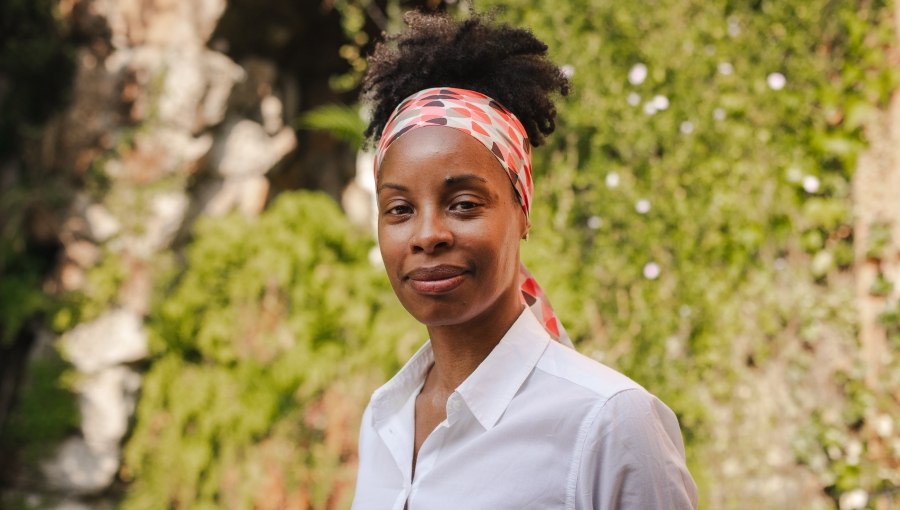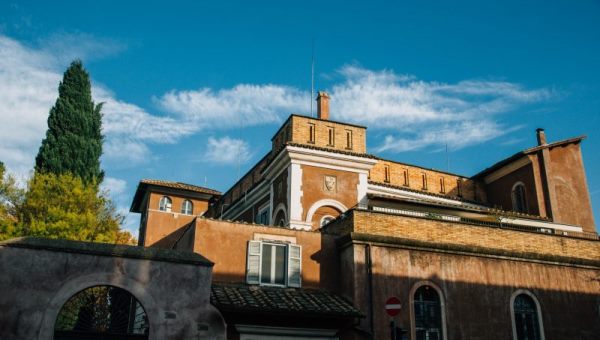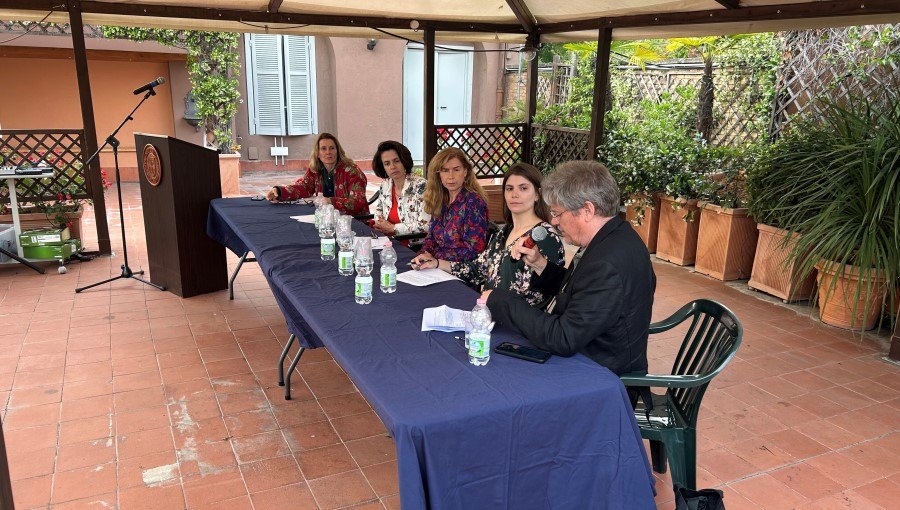JCU Welcomes Paolo Cirio for a Talk on Internet Hacktivism
John Cabot University welcomed Italian artist, activist and hacker Paolo Cirio for a talk called “Internet Hacktivism and the Art of (Digital) Defiance” on October 19, 2023. The talk was part of the Digital Delights and Disturbances lecture series organized by the Communication and Media Studies Department and was moderated by Professor Donatella Della Ratta.
Cirio, who has lived in U.S. for over 10 years, uses art and his hacker skills to raise awareness about social, economic, and cultural issues of contemporary society. His research-based artworks are presented as installations, lectures, artifacts, photos, videos, and public art, both offline and online. He has exhibited in international museums and has won prestigious art awards, and his artworks have been covered by hundreds of media outlets worldwide. As a result of his performances, Cirio has been subject to legal and personal threats by governmental authorities, multinationals, banks, law firms, as well as online audiences.

STOPtheNATO.org
One of his first projects was STOPtheNATO.org, a website that ran from 2001 to 2006 and focused on NATO militarism. Over the course of five years, the website published more than nine hundred news items about NATO’s expansion into Eastern Europe, its military bases, and its operations in the aftermath of 9/11. In addition to the distribution of information about military misconduct and the economic gains of war profiteers, the website fostered international protests and riots against the military organization. The website primarily organized Internet sit-ins to interfere with NATO’s website and its summits through participatory DDoS (distributed denial-of-service attacks, or malicious attempts to disrupt normal traffic to a web property). The project later led to an investigation by the Department of Defense of Canada and of the U.S., which forced Cirio to shut it down.
Face to Facebook
In 2011, Cirio and Italian researcher and artist Alessandro Ludovico worked on a project called Face to Facebook. They created an algorithm that harvested over one million Facebook profiles and then posted them on a custom-made dating website. He used artificial intelligence to process the data, including the pictures, and categorize the people based on their personality traits. Cirio received several letters from Facebook’s lawyers demanding that he stop his activities and delete the harvested data, and then banned him from the platform. The project addressed surveillance, privacy, and the economy of social media monopolies.
Loophole4All.com
In 2013, Cirio worked on a project called Loophole4All.com, which focused on finance and financial secrecy. He hacked the website of the Cayman Islands, a country that is known for being an offshore financial center, and leaked the names of over 250 thousand companies incorporated in the country. He then created a website called loophole4all.com where people could buy forged Certificates of Incorporation for 99 cents. As part of the conceptual work, Cirio set up his own company in London and took advantage of other jurisdictions to shield personal liability and revenues. He was committing a crime in the Cayman Islands, but his executive headquarters were in New York, while his corporate ones in London, and the payments were being processed through PayPal, which is based in Luxemburg. This performance generated international media attention as well as an outcry from the Cayman Islands’ authorities, international banking and law firms, individual owners of real companies, and PayPal.
Overexposed
In 2015, following Edward Snowden’s leaks of classified documents, Cirio worked on a project called Overexposed. He searched the internet and collected pictures of high-ranking U.S. intelligence officials of the NSA, CIA, NI, and FBI who were related to Edward Snowden’s revelations. The pictures were then disseminated onto public walls throughout major cities. The artwork critiqued the era of ubiquitous surveillance by exposing the officials responsible for secretive mass surveillance and over-classified intelligence programs.
Obscurity
Obscurity is a project that Cirio launched in 2016. He gathered over 10 million mugshots, blurred the faces and shuffled the names and information, and then posted them on several clone websites. The idea was to create noise information to obfuscate the criminal records of mugshot websites. Cirio and his artwork received both legal threats from owners of mugshot websites and support from victims of mugshot extortion. This project led Cirio to start a campaign in the U.S. called Right to Remove, an internet privacy policy that advocates for the legal right to remove personal information from search engines.
Sociality
In 2018, Cirio launched a project called Sociality. He hacked the Google Patents search engine and collected over 20 thousand patents of internet technologies designed to manipulate and/or control people. He then printed some of them out and put them up on the walls of U.S. colleges where those patents were made and published everything on the project’s website. The idea behind the project was to raise awareness of social manipulation by exposing the discrimination, polarization, addiction, deception, and surveillance behind some internet technologies, and to question their ethical, legal, and economic structures.
Capture
In 2020, Cirio gathered about 1000 public pictures of the French police taken during protests in France for his project called Capture. He used a Facial Recognition software to process them, and then posted about 4000 faces of French police officers on a website called capturepolice.com that he created. Cirio crowdsourced the officers’ information and encouraged people to identify them. He also printed out some of these pictures and pasted them around the center of Paris. French police unions protested against the project and the French interior minister threatened to bring Cirio to court should he refuse to stop. The aim of the project was to promote a campaign to ban facial recognition in Europe. The idea was to show that facial recognition can be very dangerous even for the authorities, who were the ones who advocated for it the most. Cirio collected more than 50 thousand signatures for the petition to ban facial recognition in Europe, and his efforts were met with people saying that more regulations were necessary.
The issue of climate justice
Around 2020, Cirio became interested in the climate justice issue. He explained that about 100 companies are responsible for more than 70% of greenhouse gas emissions and that today we have the evidence to hold them accountable for it. He showed some charts produced by Exxon in 1982, in which their scientists accurately predicted the effects of the company’s emission 40 years from then. Despite this knowledge, Exxon has engaged in misinformation and manipulation around climate change for the past 30 years. Similarly, in 1988, Shell studied ocean acidification and temperature increase and also kept their findings secret and spread misinformation about climate change.
Extinction Claims and The Climate Tribunal
In 2021, Cirio worked on a project called Extinction Claims to advocate for thousands of endangered species. He aggregated data and images of species and ecosystems vulnerable to climate change, coded an algorithm to calculate financial compensation that he then claimed from major oil, gas, and coal companies on behalf of the endangered species. He published the results on Extinction-Claims.com, which generated simplified legal claims and petitions for each species that could be submitted by the public to government agencies and used for lawsuits against major polluters. The aim of the project was to make information about endangered species more accessible, while also showing the massive scale of the crisis and holding from major oil, gas, and coal companies accountable.
Cirio then launched a project called The Climate Tribunal. He collected evidence like pictures, graphs, and documents that showed the greenhouse gas emissions of major oil, gas, and coal companies. Like a tribunal case, he presented evidence, named plaintiffs and defendants, had climate crisis experts as witnesses, and let the audience participate as jury or identify as an injured party.
Climate Class Action
Cirio’s current project is called Climate Class Action, and it allows people to sue major fossil fuel companies for personal damages caused by floods, drought, wildfires, hurricanes, heat waves, coastal erosion, and other natural disasters caused by climate change. He created a website called ClimateClassAction.com that enables users to estimate financial compensation for damages caused by climate change. The aim of the project is to build a community of people affected by the climate crisis, and to eventually organize a real class action suit.
Q&A
In the Q&A session, Cirio briefly talked about copyright, and explained that it has changed compared to twenty years ago. He explained that until a few years ago, hackers would fight copyright because they considered it a barrier to access information and knowledge, but that today copyright can be good or bad based on the context. He also added that despite him advocating for less regulation and for the internet to be a free space when he first began working, he now realizes that we need more regulations.





